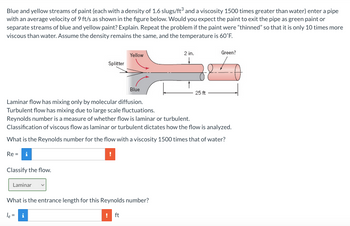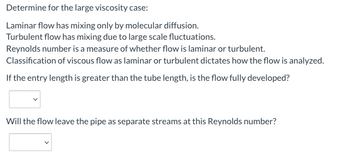
Elements Of Electromagnetics
7th Edition
ISBN: 9780190698614
Author: Sadiku, Matthew N. O.
Publisher: Oxford University Press
expand_more
expand_more
format_list_bulleted
Concept explainers
Question

Transcribed Image Text:Blue and yellow streams of paint (each with a density of 1.6 slugs/ft³ and a viscosity 1500 times greater than water) enter a pipe
with an average velocity of 9 ft/s as shown in the figure below. Would you expect the paint to exit the pipe as green paint or
separate streams of blue and yellow paint? Explain. Repeat the problem if the paint were "thinned" so that it is only 10 times more
viscous than water. Assume the density remains the same, and the temperature is 60°F.
Classify the flow.
Splitter
Laminar
Yellow
Blue
Laminar flow has mixing only by molecular diffusion.
Turbulent flow has mixing due to large scale fluctuations.
Reynolds number is a measure of whether flow is laminar or turbulent.
Classification of viscous flow as laminar or turbulent dictates how the flow is analyzed.
What is the Reynolds number for the flow with a viscosity 1500 times that of water?
Re=
2 in.
What is the entrance length for this Reynolds number?
le=
ft
Green?
25 ft

Transcribed Image Text:Determine for the large viscosity case:
Laminar flow has mixing only by molecular diffusion.
Turbulent flow has mixing due to large scale fluctuations.
Reynolds number is a measure of whether flow is laminar or turbulent.
Classification of viscous flow as laminar or turbulent dictates how the flow is analyzed.
If the entry length is greater than the tube length, is the flow fully developed?
Will the flow leave the pipe as separate streams at this Reynolds number?
Expert Solution
This question has been solved!
Explore an expertly crafted, step-by-step solution for a thorough understanding of key concepts.
Step by stepSolved in 4 steps with 4 images

Knowledge Booster
Learn more about
Need a deep-dive on the concept behind this application? Look no further. Learn more about this topic, mechanical-engineering and related others by exploring similar questions and additional content below.Similar questions
- I would really appreciate it if you could tell me how to solve the problem.arrow_forwardLiquid flows at a rate of 1.5 L/min in a circular tube with a diameter of 5 mm. inside a circular tubeThe vascular endothelial cells are attached. One cell has a surface area of 500 μm2. To be attached to the inner wall of the tube. What force does one cell have to withstand? The viscosity of the liquid is 1.2 cP = 0.0012 Pass.arrow_forwardTwo plates are positioned at distance of 1.3 mm from each other. One of the plates is moving at velocity of 0.5 m/s; the movement requires a shear stress of 5 N/m². Calculate dynamic viscosity of the fluid between the plates by assuming linear velocity distribution. Round off the answer to three decimal digits in kg/ms, but enter the answer without the unit. Answer:arrow_forward
- You have a container like the one shown in figure 1 from which you want to extract liquid with the help of asiphon (inverted U-shaped tube). The siphon should be filled initially, but once this is done theliquid will flow until its level drops below opening A. The liquid has a density ?, and anegligible viscosity. Assume that the area of the container is very large compared to the area of thetube and that both the tube at C and the container itself at D are open to the atmosphere. a) Using Bernoulli's equation and comparing points "D" and "C", determine the speed with which the liquid flows in C. b) What is the gauge pressure of the liquid at the highest point (B)? c) What maximum height H can the highest point (B) of the tube have without ceasing to have flow? d) If the liquid of density ? is changed, for one with density ?2 where ? < ?2, will there be any change in velocity at C? If there is any change, write down with which liquid the highest speed is obtained in C, otherwise…arrow_forwardConsider flow of blood in the microvessels of the body, assuming Poiseuille’s law holds and that the viscosity of the blood is constant. Consider a parent vessel that bifurcates into two daughter segments, all within the microcirculation and with blood flow described using Poiseuille’s law (assume that each segment has a different diameter and length).Denoting the pressure at node i by pi (i=1,2,3,4), and the flux in segment j by Qj (j=1,2,3), write down expressions for the segment fluxes in the network, in terms of the nodal pressures. How are the three volume fluxes related, and why? Assuming that the pressures at nodes 1, 3, 4 (the boundary nodes) are known, write down an expression for the pressure at the interior node, p2.arrow_forward
arrow_back_ios
arrow_forward_ios
Recommended textbooks for you
 Elements Of ElectromagneticsMechanical EngineeringISBN:9780190698614Author:Sadiku, Matthew N. O.Publisher:Oxford University Press
Elements Of ElectromagneticsMechanical EngineeringISBN:9780190698614Author:Sadiku, Matthew N. O.Publisher:Oxford University Press Mechanics of Materials (10th Edition)Mechanical EngineeringISBN:9780134319650Author:Russell C. HibbelerPublisher:PEARSON
Mechanics of Materials (10th Edition)Mechanical EngineeringISBN:9780134319650Author:Russell C. HibbelerPublisher:PEARSON Thermodynamics: An Engineering ApproachMechanical EngineeringISBN:9781259822674Author:Yunus A. Cengel Dr., Michael A. BolesPublisher:McGraw-Hill Education
Thermodynamics: An Engineering ApproachMechanical EngineeringISBN:9781259822674Author:Yunus A. Cengel Dr., Michael A. BolesPublisher:McGraw-Hill Education Control Systems EngineeringMechanical EngineeringISBN:9781118170519Author:Norman S. NisePublisher:WILEY
Control Systems EngineeringMechanical EngineeringISBN:9781118170519Author:Norman S. NisePublisher:WILEY Mechanics of Materials (MindTap Course List)Mechanical EngineeringISBN:9781337093347Author:Barry J. Goodno, James M. GerePublisher:Cengage Learning
Mechanics of Materials (MindTap Course List)Mechanical EngineeringISBN:9781337093347Author:Barry J. Goodno, James M. GerePublisher:Cengage Learning Engineering Mechanics: StaticsMechanical EngineeringISBN:9781118807330Author:James L. Meriam, L. G. Kraige, J. N. BoltonPublisher:WILEY
Engineering Mechanics: StaticsMechanical EngineeringISBN:9781118807330Author:James L. Meriam, L. G. Kraige, J. N. BoltonPublisher:WILEY

Elements Of Electromagnetics
Mechanical Engineering
ISBN:9780190698614
Author:Sadiku, Matthew N. O.
Publisher:Oxford University Press

Mechanics of Materials (10th Edition)
Mechanical Engineering
ISBN:9780134319650
Author:Russell C. Hibbeler
Publisher:PEARSON

Thermodynamics: An Engineering Approach
Mechanical Engineering
ISBN:9781259822674
Author:Yunus A. Cengel Dr., Michael A. Boles
Publisher:McGraw-Hill Education

Control Systems Engineering
Mechanical Engineering
ISBN:9781118170519
Author:Norman S. Nise
Publisher:WILEY

Mechanics of Materials (MindTap Course List)
Mechanical Engineering
ISBN:9781337093347
Author:Barry J. Goodno, James M. Gere
Publisher:Cengage Learning

Engineering Mechanics: Statics
Mechanical Engineering
ISBN:9781118807330
Author:James L. Meriam, L. G. Kraige, J. N. Bolton
Publisher:WILEY